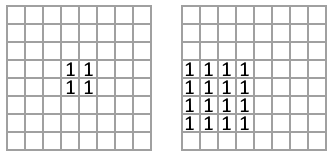311044: CF1926B. Vlad and Shapes
Description
Vladislav has a binary square grid of $n \times n$ cells. A triangle or a square is drawn on the grid with symbols $\texttt{1}$. As he is too busy being cool, he asks you to tell him which shape is drawn on the grid.
- A triangle is a shape consisting of $k$ ($k>1$) consecutive rows, where the $i$-th row has $2 \cdot i-1$ consecutive characters $\texttt{1}$, and the central 1s are located in one column. An upside down triangle is also considered a valid triangle (but not rotated by 90 degrees).
 Two left pictures contain examples of triangles: $k=4$, $k=3$. The two right pictures don't contain triangles.
Two left pictures contain examples of triangles: $k=4$, $k=3$. The two right pictures don't contain triangles. - A square is a shape consisting of $k$ ($k>1$) consecutive rows, where the $i$-th row has $k$ consecutive characters $\texttt{1}$, which are positioned at an equal distance from the left edge of the grid.
 Examples of two squares: $k=2$, $k=4$.
Examples of two squares: $k=2$, $k=4$. For the given grid, determine the type of shape that is drawn on it.
InputThe first line contains a single integer $t$ ($1 \leq t \leq 100$) — the number of test cases.
The first line of each test case contains a single integer $n$ ($2 \leq n \leq 10$) — the size of the grid.
The next $n$ lines each contain $n$ characters $\texttt{0}$ or $\texttt{1}$.
The grid contains exactly one triangle or exactly one square that contains all the $\texttt{1}$s in the grid. It is guaranteed that the size of the triangle or square is greater than $1$ (i.e., the shape cannot consist of exactly one 1).
OutputFor each test case, output "SQUARE" if all the $\texttt{1}$s in the grid form a square, and "TRIANGLE" otherwise (without quotes).
ExampleInput6 3 000 011 011 4 0000 0000 0100 1110 2 11 11 5 00111 00010 00000 00000 00000 10 0000000000 0000000000 0000000000 0000000000 0000000000 1111111110 0111111100 0011111000 0001110000 0000100000 3 111 111 111Output
SQUARE TRIANGLE SQUARE TRIANGLE TRIANGLE SQUARE
Output
Vlad 有一个 $ n \times n $ 的二进制方格。在这个方格上用符号 `1` 画了一个三角形或一个正方形。由于他太忙于装酷,他要求你告诉他方格上画的是哪个形状。
- 一个三角形是由 $ k $ ($ k > 1 $) 连续的行组成,其中第 $ i $ 行有 $ 2 \times i - 1 $ 个连续的字符 `1`,并且中间的 `1` 位于同一列。倒三角形也被认为是有效的三角形(但不是旋转 90 度的)。
- 一个正方形是由 $ k $ ($ k > 1 $) 连续的行组成,其中第 $ i $ 行有 $ k $ 个连续的字符 `1`,这些字符位于与网格左边缘等距离的位置。
给定一个方格,确定方格上画的形状的类型。
输入数据格式:
第一行包含一个整数 $ t $ ($ 1 \leq t \leq 100 $) —— 测试用例的数量。
每个测试用例的第一行包含一个整数 $ n $ ($ 2 \leq n \leq 10 $) —— 方格的大小。
接下来的 $ n $ 行每行包含 $ n $ 个字符 `0` 或 `1`。
方格中恰好有一个三角形或一个正方形,包含所有的 `1`。保证三角形或正方形的大小大于 1(即形状不能完全由一个 `1` 组成)。
输出数据格式:
对于每个测试用例,如果方格中的所有 `1` 组成一个正方形,输出 "SQUARE",否则输出 "TRIANGLE"(不带引号)。题目大意: Vlad 有一个 $ n \times n $ 的二进制方格。在这个方格上用符号 `1` 画了一个三角形或一个正方形。由于他太忙于装酷,他要求你告诉他方格上画的是哪个形状。 - 一个三角形是由 $ k $ ($ k > 1 $) 连续的行组成,其中第 $ i $ 行有 $ 2 \times i - 1 $ 个连续的字符 `1`,并且中间的 `1` 位于同一列。倒三角形也被认为是有效的三角形(但不是旋转 90 度的)。 - 一个正方形是由 $ k $ ($ k > 1 $) 连续的行组成,其中第 $ i $ 行有 $ k $ 个连续的字符 `1`,这些字符位于与网格左边缘等距离的位置。 给定一个方格,确定方格上画的形状的类型。 输入数据格式: 第一行包含一个整数 $ t $ ($ 1 \leq t \leq 100 $) —— 测试用例的数量。 每个测试用例的第一行包含一个整数 $ n $ ($ 2 \leq n \leq 10 $) —— 方格的大小。 接下来的 $ n $ 行每行包含 $ n $ 个字符 `0` 或 `1`。 方格中恰好有一个三角形或一个正方形,包含所有的 `1`。保证三角形或正方形的大小大于 1(即形状不能完全由一个 `1` 组成)。 输出数据格式: 对于每个测试用例,如果方格中的所有 `1` 组成一个正方形,输出 "SQUARE",否则输出 "TRIANGLE"(不带引号)。